Paul Gilster's Blog, page 126
July 4, 2017
M-Dwarf Habitability: New Work on Flares
The prospects for life around M-dwarf stars, always waxing and waning depending on current research, have dimmed again with the release of new work from Christina Kay (NASA GSFC) and colleagues. As presented at the National Astronomy Meeting at the University of Hull (UK), the study takes on the question of space weather and its effect on habitability.
We know that strong solar flares can disrupt satellites and ground equipment right here on Earth. But habitable planets around M-dwarfs — with liquid water on the surface — must orbit far closer to their star than we do. Proxima Centauri b, for example, is roughly 0.05 AU from its small red host (7,500,000 km), while all seven of the TRAPPIST-1 planets orbit much closer than Mercury orbits the Sun. What, then, could significant flare activity do to such vulnerable worlds?
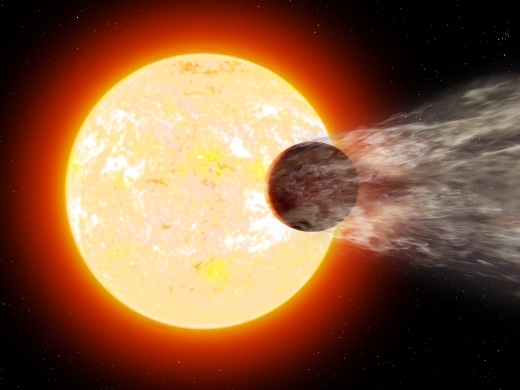
Image: Artist’s impression of HD 189733b, showing the planet’s atmosphere being stripped by the radiation from its parent star. Credit: Ron Miller.
Working with Merav Opher and Marc Kornbleuth (both at Boston University), Kay has homed in on coronal mass ejections (CMEs), the vast upheavals that throw stellar plasma into nearby space. While red dwarf stars are significantly cooler than our G-class Sun, their CMEs are thought to be far stronger because of their enhanced magnetic fields. From the paper:
Stellar activity tends to increase with the size of the stellar convection envelope (West et al. 2004) and stellar rotation rates (Mohanty et al. 2002; West et al. 2015), although the activity saturates for sufficiently high rotational velocity (Delfosse et al. 1998). For mid- to late-type M dwarfs (M4 to M8.5) the activity saturates at higher rotational velocities than for early-type M dwarfs, and above M9 the activity levels decrease significantly (Mohanty et al. 2002). Accordingly, most M dwarf stars will have significantly enhanced stellar activity as compared to the Sun.
A strong planetary magnetic field could counteract at least some of the resulting flare activity, but even there a possibility of strong erosion of the atmosphere remains. And if the planet is tidally locked, some recent work suggests little to no magnetic field can be expected.
The paper outlines the process when a CME hits a nearby planet. One problem is extreme ultraviolet and X-ray flux (XUV) which can heat the upper atmosphere and perhaps ionize it. If such radiation gets through to the surface, it can damage any potential life-forms there. While it turns out that an M-dwarf habitable zone planet receives an order of magnitude less XUV flux than Earth when the star is quiet, the flux jumps as high as 100 times Earth’s during the star’s frequent flare activity.
Significant CME activity also makes the planet much less likely to retain its atmosphere as a shield for life on the surface. A CME compresses whatever magnetosphere the planet has, and in extreme cases, say the authors, can exert enough pressure to shrink the magnetosphere to the point where the atmosphere can be seriously eroded.
Modeling an Astrospheric Current Sheet
Kay’s team modeled the effects of theoretical CMEs on the red dwarf V374 Pegasi, using a tool Kay developed for CME modeling called ForeCAT. They found that the strong magnetic fields of the star produce CMEs that can reach the so-called Astrospheric Current Sheet, where the background magnetic field is at its minimum. The same effect occurs with our Sun, when solar CMEs are deflected by magnetic forces toward the minimum magnetic energy.
At the Sun, the Heliospheric Current Sheet — the local analog to a different star’s Astrospheric Current Sheet — is a field that extends along the Sun’s equatorial plane in the heliosphere and is shaped by the effect of the Sun’s rotating magnetic field on the plasma in the solar wind. The HCS separates regions of the solar wind where the magnetic field points toward or away from the Sun.
Let’s dwell on that for a moment. Here’s what a NASA fact sheet has to say about the Heliospheric Current Sheet:
The sun’s magnetic field permeates the entire solar system called the heliosphere. All nine planets orbit inside it. But the biggest thing in the heliosphere is not a planet, or even the sun. It’s the current sheet — a sprawling surface where the polarity of the sun’s magnetic field changes from plus (north) to minus (south). A small electrical current flows within the sheet, about 10−10 A/m². The thickness of the current sheet is about 10,000 km near the orbit of the Earth. Due to the tilt of the magnetic axis in relation to the axis of rotation of the sun, the heliospheric current sheet flaps like a flag in the wind. The flapping current sheet separates regions of oppositely pointing magnetic field, called sectors.
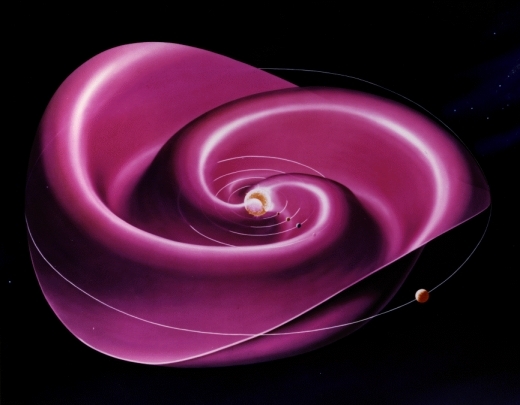
Image: The Heliospheric Current Sheet results from the influence of the Sun’s rotating magnetic field on the plasma in the interplanetary medium (solar wind). The wavy spiral shape has been likened to a ballerina’s skirt. The new work uses a software modeling package called ForeCAT to study interactions between CMEs and the Astrospheric Current Sheet around the red dwarf V374 Pegasi. Credit: NASA GSFC.
Kay and team have modeled the Astrospheric Current Sheet expected to be found around M-dwarfs like V374 Pegasi. The authors find that upon reaching the ACS, CMEs become ‘trapped’ along it. Planets can dip into and out of the ACS as they orbit. A CME moving out into the Astrospheric Current Sheet around an M-dwarf can cancel out a habitable zone planet’s local magnetic field, opening the world to devastating flare effects. The upshot:
We expect that rocky exoplanets cannot generate sufficient magnetic field to shield their atmosphere from mid-type M dwarf CMEs… We expect that the minimum magnetic field strength will change with M dwarf spectral type as the amount of stellar activity and stellar magnetic field strength change, and that early-type M dwarfs would be more likely to retain an atmosphere than mid or late-type M dwarfs.
The authors calculate that a mid-type M-dwarf planet would need a minimum planetary magnetic field between tens to hundreds of Gauss to retain an atmosphere, values that are far higher than Earth’s (0.25 to 0.65 gauss). CME impacts as numerous as five per day could occur for planets near the star’s Astrospheric Current Sheet. The only mitigating factor is that the rate decreases for planets in inclined orbits. The paper notes:
The sensitivity to the inclination is much greater for the mid-type M dwarf exoplanets due to the extreme deflections to the Astrospheric Current Sheet. For low inclinations we find a probability of 10% whereas the probability decreases to 1% for high inclinations. From our estimation of 50 CMEs per day, we expect habitable mid-type M dwarf exoplanets to be impacted 0.5 to 5 times per day, 2 to 20 times the average at Earth during solar maximum. The frequency of CME impacts may have significant implications for exoplanet habitability if the impacts compress the planetary magnetosphere leading to atmospheric erosion.
So we have much to learn about M-dwarfs. In particular, how accurate is the ForeCAT model in developing the CME scenario around such stars? As we examine such modeling, we have to keep in mind that magnetic field strength will change with the type of M-dwarf we are dealing with. Based on this research, only early M-dwarfs are likely to maintain an atmosphere.
The paper is Kay, Opher and Kornbleuth, “Probability of CME Impact on Exoplanets Orbiting M Dwarfs and Solar-Like Stars,” accepted at the Astrophysical Journal (preprint).






June 30, 2017
‘Cosmic Modesty’ in a Fecund Universe
I came across the work of Chin-Fei Lee (Academia Sinica Institute of Astronomy and Astrophysics, Taiwan) when I had just read Avi Loeb’s essay Cosmic Modesty. Loeb (Harvard University) is a well known astronomer, director of the Institute for Theory and Computation at the Harvard-Smithsonian Center for Astrophysics and a key player in Breakthrough Starshot. His ‘cosmic modesty’ implies we should accept the idea that humans are not intrinsically special. Indeed, given that the only planet we know that hosts life has both intelligent and primitive lifeforms on it, we should search widely, and not just around stars like our Sun.
More on that in a moment, because I want to intertwine Loeb’s thoughts with recent work by Chin-Fei Lee, whose team has used the Atacama Large Millimeter/submillimeter Array (ALMA) to detect organic molecules in an accretion disk around a young protostar. The star in question is Herbig-Haro (HH) 212, an infant system (about 40,000 years old) in Orion about 1300 light years away. Seen nearly edge-on from our perspective on Earth, the star’s accretion disk is feeding a bipolar jet. This team’s results, to my mind, remind us why cosmic modesty seems like a viable course, while highlighting the magnitude of the question.
What Lee’s team has found at HH 212 is an atmosphere of complex organic molecules associated with the disk. Methanol (CH3OH) is involved, as is deuterated methanol (CH2DOH), methanethiol (CH3SH), and formamide (NH2CHO), which the researchers see as precursors for producing biomolecules like amino acids and sugars. “They are likely formed on icy grains in the disk and then released into the gas phase because of heating from stellar radiation or some other means, such as shocks,” says co-author Zhi-Yun Li of the University of Virginia.
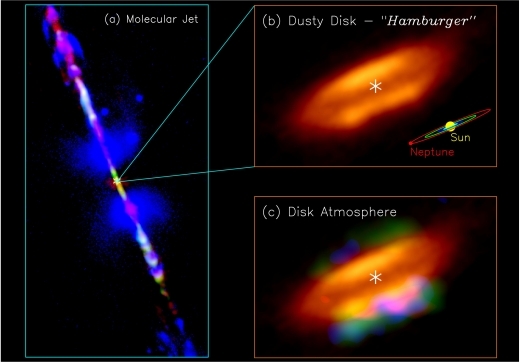
Image: Jet, disk, and disk atmosphere in the HH 212 protostellar system. (a) A composite image for the HH 212 jet in different molecules, combining the images from the Very Large Telescope (McCaughrean et al. 2002) and ALMA (Lee et al. 2015). Orange image shows the dusty envelope+disk mapped with ALMA. (b) A zoom-in to the central dusty disk. The asterisk marks the position of the protostar. A size scale of our solar system is shown in the lower right corner for comparison. (c) Atmosphere of the accretion disk detected with ALMA. In the disk atmosphere, green is for deuterated methanol, blue for methanethiol, and red for formamide. Credit: ALMA (ESO/NAOJ/NRAO)/Lee et al.
Every time I read about finds like this, I think about the apparent ubiquity of life’s materials — here we’re seeing organics at the earliest phases of a stellar system’s evolution. The inescapable conclusion is that the building blocks of living things are available from the outset to be incorporated in the planets that emerge from the disk. That certainly doesn’t count as a detection of life, but it does remind us of how frequently the ingredients of life manage to appear.
In that context, Avi Loeb’s thoughts on cosmic modesty ring true. We’ve been able to extract some statistical conclusions from the Kepler instrument’s deep stare that let us infer there are more Earth-mass planets in the habitable zones of their stars in the observable universe than there are grains of sand on all the Earth’s beaches. Something to think about as you read this on your beach vacation and gaze from the sand beneath your feet to the ocean beyond.
But are most living planets likely to occur around G-class stars like our Sun? Loeb reminds us that red dwarf stars like Proxima Centauri b and TRAPPIST-1, both of which made headlines in the past year because of their conceivably habitable planets, are long-lived, with lifetimes as long as 10 trillion years. Our Sun’s life, by comparison, is a paltry 10 billion years. Long after the Sun has turned into a white dwarf after its red giant phase, living things could still have a habitat around Proxima Centauri and TRAPPIST-1. Says Loeb:
I therefore advise my wealthy friends to buy real estate on Proxima b, because its value will likely go up dramatically in the future. But this also raises an important scientific question: “Is life most likely to emerge at the present cosmic time near a star like the sun?” By surveying the habitability of the universe throughout cosmic history from the birth of the first stars 30 million years after the big bang to the death of the last stars in 10 trillion years, one reaches the conclusion that unless habitability around low-mass stars is suppressed, life is most likely to exist near red dwarf stars like Proxima Centauri or TRAPPIST-1 trillions of years from now.
But of course, one of the reasons for missions like TESS (Transiting Exoplanet Survey Satellite) is to begin to understand the small rocky worlds around nearby red dwarfs, and to determine whether there are factors like tidal lock or stellar flaring that preclude life there. For that matter, do the planets around Proxima and TRAPPIST-1 have atmospheres? There too the answer will be forthcoming, assuming the James Webb Space Telescope is deployed successfully and can make the needed assessment of these worlds.
…very advanced civilizations [Loeb continues] could potentially be detectable out to the edge of the observable universe through their most powerful beacons. The evidence for an alien civilization might not be in the traditional form of radio communication signals. Rather, it could involve detecting artifacts on planets via the spectral edge from solar cells, industrial pollution of atmospheres, artificial lights or bursts of radiation from artificial beams sweeping across the sky.
Changes to the traditional view of SETI abound as we explore these new pathways. In any case, our technologies for making such detections have never been as advanced, and work across the exoplanetary spectrum, such as the findings of Chin-Fei Lee and colleagues, urges us on as we try to relate our own civilization to a universe in which it is hardly the center. As Loeb reminds us, we are orbiting a galaxy that itself moves at ~0.001c relative to the cosmic rest frame, one of perhaps 100 billion galaxies in the observable universe.
Either alternative — we are alone, or we are not — changes everything about our perspective, and encourages us to deepen the search for simple life (perhaps detected in exoplanetary atmospheres through its biosignatures) as well as conceivable alien civilizations. Embracing Loeb’s cosmic modesty, we press on under the assumption that life’s emergence is not uncommon, and that refining the search to learn the answer is a civilizational imperative.






June 29, 2017
Magnetic Reconnection at the ‘Planet of Doubt’
Perhaps the image of Uranus just below helps explain why the planet has been treated so sparsely in science fiction. Even this Voyager view shows us a featureless orb, and certainly in visible light the world has little to make it stand out other than its unusual axis of rotation, which is titled so that its polar regions are where you would expect its equator to be. Geoff Landis’ “Into the Blue Abyss” (2001) is the best fictional treatment I know, but the fog-shrouded Uranus of Stanley G. Weinbaum’s “The Planet of Doubt” (1935) has its own charms, though obviously lacking the scientific verisimilitude of the Landis tale.
My admiration for Gerald Nordley’s “Into the Miranda Rift” (1993) is unabated, taking us into this strange world’s most dramatic moon, while I should also mention Kim Stanley Robinson’s visit to Uranus in Blue Mars (1997), where the moon is established as a protected wilderness site while the rest of the Uranian satellite system is under colonization. Fritz Leiber’s “Snowbank Orbit” (1962) explores aero-braking at Uranus, while Larry Niven’s A World Out of Time (1976) maneuvers the planet to adjust the Earth’s own orbit.
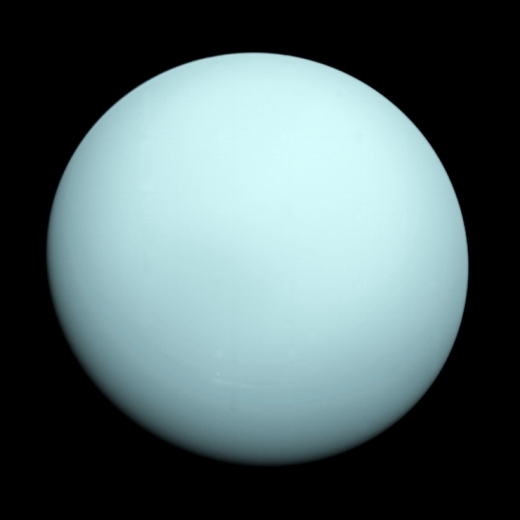
Image: The planet Uranus as seen by Voyager 2, which flew closely past the seventh planet in January of 1986. Credit: NASA/JPL.
I will spare you the 1962 film Journey to the Seventh Planet and move on to new work on Uranus out of the Georgia Institute of Technology, where researchers have discovered that the magnetosphere of the planet ‘flips on and off like a light switch’ (according to this Georgia Tech news release) as it rotates along with the planet. In one orientation, the solar wind flows into the magnetosphere, which later closes to deflect that same wind away from Uranus.
Rotating on its side, Uranus also has a magnetic field that is off-centered and tilted 60 degrees from its axis of rotation. What we wind up with is rapid rotational reorientation, keeping the field strength turbulent. Carol Paty (Georgia Tech), a co-author of the study, puts the matter this way:
“Uranus is a geometric nightmare. The magnetic field tumbles very fast, like a child cartwheeling down a hill head over heels. When the magnetized solar wind meets this tumbling field in the right way, it can reconnect and Uranus’ magnetosphere goes from open to closed to open on a daily basis.”
Compare this with the Earth, where the magnetic field is nearly aligned with the planet’s spin axis, which means that the magnetosphere spins along with the Earth’s rotation. Even so, disruptive events can occur because of geomagnetic storms. A strong solar storm disrupting the magnetic fields of the solar wind can reconfigure Earth’s field from closed to open, rearranging the local magnetic topology to allow a surge of solar energy to enter the system. Such reconnection happens throughout the Solar System, and occurs when the direction of the heliospheric magnetic field is opposite to a planet’s magnetospheric alignment.
Geomagnetic storms produced by coronal mass ejections slamming into Earth’s magnetic field can produce spectacular aurora events while playing havoc with radio communications. Reconnection drives the entire process, happening in the presence of plasma, which carries its own magnetic fields in a constantly adjusting dance between charged particles and fields. Sudden changes in the alignment of the magnetic field lines convert the stored energy of the magnetic fields into heat and kinetic energy that drives particles along the field lines.
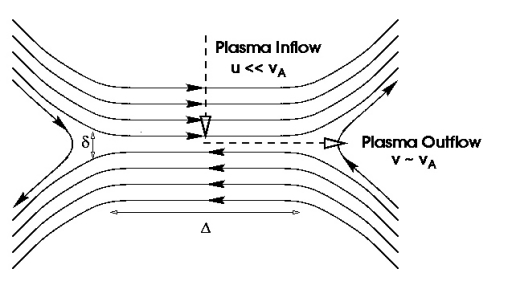
Image: Magnetic reconnection (henceforth called “reconnection”) refers to the breaking and reconnecting of oppositely directed magnetic field lines in a plasma. In the process, magnetic field energy is converted to plasma kinetic and thermal energy. Credit: Magnetic Reconnection Experiment.
Thus a surge of energy enters the system. Such magnetic reconnection should produce auroras at various latitudes on Uranus even if they are a challenge to observe from Earth. The Georgia Tech team’s numerical models predict the most likely places on the planet for reconnection, working with Voyager 2 data from the 1986 flyby. Lead author Xin Cao comments:
“The majority of exoplanets that have been discovered appear to also be ice giants in size. Perhaps what we see on Uranus and Neptune is the norm for planets: very unique magnetospheres and less-aligned magnetic fields. Understanding how these complex magnetospheres shield exoplanets from stellar radiation is of key importance for studying the habitability of these newly discovered worlds.”
The paper is Cao and Paty, “Diurnal and seasonal variability of Uranus’s magnetosphere,” published online by the Journal of Geophysical Research: Space Physics 27 June 2017 (abstract).






June 28, 2017
Planet 9? Planet 10? Planet X?
When you find a protoplanetary disk that displays unusual properties, the suspicion grows that an unseen planet is causing the phenomenon. The young Beta Pictoris is a classic case in point: Here we see disk asymmetry, with one side of the disk appearing longer and thinner than the other, and a warp that could be caused by the planet known as Beta Pictoris b.
Or consider an extreme case, HD 142527. A T Tauri star in Lupus, HD 142527 displays an inner disk that is tilted by about 70 degrees (see HD 142527: Shadows of a Tilted Disk). Such a striking offset could be caused by an encounter with another star, though there no good candidates. Are we seeing the effects of proto-planets?

All this comes to mind because of what Kat Volk (JPL) and Renu Malhotra (Lunar and Planetary Laboratory, University of Arizona) are seeing in our own Solar System. Their analysis of the more distant regions of the Kuiper Belt shows that objects there display an offset of about eight degrees from the so-called ‘invariable plane’ of the Solar System.
That tilt needs explanation, and the authors of the new paper speculate that it’s the result of an unseen mass. We may be dealing with a Mars-sized object orbiting roughly 60 AU from the Sun, its orbit tilted by that same eight degrees to the average plane of the known planets.
Image: Lunar & Planetary Laboratory scientist Renu Malhotra. Credit: UA.
Let’s dig a little deeper into this. By the ‘invariable plane’ the authors mean the average inclination of objects orbiting the Sun. In our system, most of this effect comes from the angular momenta of the gas giants, and we find that the plane is within 0.5° of the orbital plane of Jupiter. No surprise there, but when Volk and Malhotra studied the orbital planes of some 600 Kuiper Belt objects, they found the aforementioned tilt of eight degrees in KBOs from 50 to 80 AU from the Sun.
While closer KBOs remain near the invariable plane, more distant KBOs do not. The researchers believe the finding is statistically unlikely to be a fluke due to the the observational sample, putting the possibility in the 1-3% range. Calculating the effects of a planetary mass object on a band of KBOs from 50 to 80 AU, Volk and Malhotra believe they are seeing the effect of something larger than a typical dwarf planet.
Whether or not we are dealing with something as massive as a planet depends upon the strength of alternative explanations. The authors discount the idea that a passing star could have disrupted the Kuiper Belt. From the paper:
… such a perturbation would have to have occurred recently enough that subsequent secular precession of these new orbit planes about the invariable plane has not had sufficient time to relax the KBOs’ mean plane. The precession timescale at a = 50 au is ∼ 5 Myr and it is ∼ 15 Myr at a = 80 au. This means that any transient impulse perturbation of the mean plane of objects in this semi-major axis range will tend to be erased by differential secular precession about the invariable plane on timescales of ∼ 10 Myr. This timescale implies a perturbation much too recent to be a result of stellar flybys (e.g., Levison et al. 2004) or rogue planets (e.g., Gladman & Chan 2006).
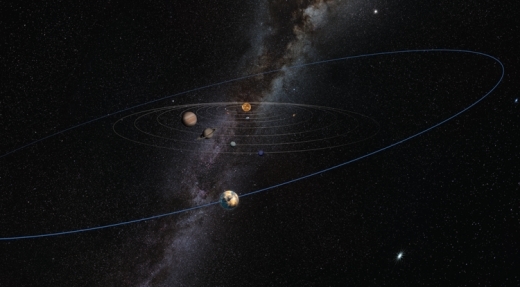
Image: A yet to be discovered, unseen “planetary mass object” makes its existence known by ruffling the orbital plane of distant Kuiper Belt objects, according to research by Kat Volk and Renu Malhotra of the UA’s Lunar and Planetary Laboratory. The object is pictured on a wide orbit far beyond Pluto in this artist’s illustration. Credit: Heather Roper/LPL.
A planet in the outer Solar System inevitably calls up thoughts of the still sought Planet 9 (or, if you prefer, Planet X), a massive object if it exists, and one predicted to be as much as 700 AU from the Sun. Malhotra and Volk are working with something much closer:
Achieving a significant change of the mean plane in the 50–80 au semi-major axis range requires a much closer perturber, because, absent a secular resonance, the forced plane of a KBO is nearly unaffected by an additional planet unless the KBO’s semi-major axis is sufficiently near that of the planet.
We can say a few things about such an object. The authors argue that the observed population of KBOs in the 50 to 100 AU range places an upper limit on its mass. Too much mass and the object would have cleared this region of KBOs over the age of the Solar System — the largest possible value for its mass can be calculated at 2.4 Earth masses. A Mars mass object on a moderately inclined orbit at a semimajor axis of 65-80 AU fits the data well.
As to why such an object has yet to be detected, the authors note the difficulties working in regions near the galactic plane and also point to unsurveyed regions at higher ecliptic latitudes where relatively bright objects (magnitude ~ 17, assuming an albedo based on an icy dwarf planet’s surface) might be hard to spot. “It appears not impossible that a perturber on the order of Mars’ size and mass, at such close distances (∼ 65–80 au, as required to perturb the Kuiper belt’s mean plane) remains to be discovered.”
This University of Arizona news release offers Malhotra’s speculation that the Large Synoptic Survey Telescope, scheduled for first light in 2020, may be able to spot the object. Indeed, the instrument’s surveys are expected to increase the number of observed KBOs from 2000 to 40,000, an increase great enough to offer hope that we’ll find any objects like these.
The paper is Volk & Malhotra, “The curiously warped mean plane of the Kuiper belt,” accepted at the Astronomical Journal (preprint).






June 27, 2017
New Horizons: Occultations in Preparation for MU69
Our spacecraft have never encountered an object as far from Earth as 2014 MU69, but New Horizons will change all that when it races past the Kuiper Belt object on New Year’s Day of 2019. This summer is an interesting part of the project because planners will use it to gather as much information as possible about what they’ll find at the target. We have three occultations to work with, one of them just past, and they are as tricky as it gets.
But before I get to the occultations, let me offer condolences to the family and many New Horizons friends of Lisa Hardaway, who died in January at age 50. Hardaway helped to develop the LEISA (Linear Etalon Imaging Spectral Array) spectrometer that brought us such spectacular results during the Pluto/Charon flyby. She was program manager at Ball Aerospace for the Ralph instrument that contains LEISA. Mission scientists used data from the instrument package to make geological, color and composition maps of Pluto and its moons. The mission team has now dedicated the spectrometer in her memory.
“Lisa played a critical role on several of Ball’s more significant scientific programs from New Horizons, Hubble and Orion, to the Boeing F/A 18 E/F fighter jet and other national defense projects,” said Rob Strain, president of Ball Aerospace in Boulder, Colorado. “She made a positive impact on the careers of many, and her contributions will continue to give back for years to come.”
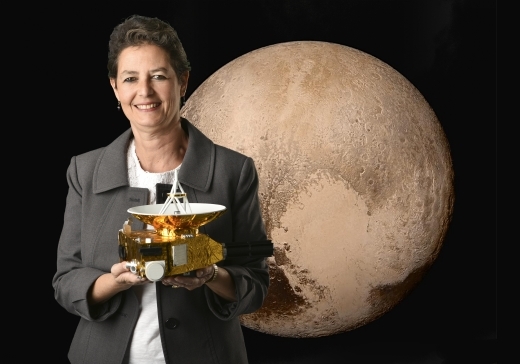
Image: Aerospace engineer Lisa Hardaway with the New Horizons spacecraft and Pluto. Hardaway was program manager for the Ralph instrument, which captured the first close-up color images of Pluto. Credit: Ball Aerospace.
Tracking a Fleeting Shadow
The MU69 occultations should provide useful data as we learn more about the KBO encounter environment. The first event occurred on June 2-3, with observers in Argentina and South Africa — 54 telescope teams in all — trying to track the shadow of MU69, which had occulted a star. Alan Stern, principal investigator for New Horizons, explains the goal:
“A tremendous amount had to go right to correctly execute such a massive observation campaign, but it did. The main goal of these observations was to search for hazards; the secondary objective was to try to glimpse the occultation of MU69 itself, in order to learn its precise size. Scouring all the dozens of datasets for these two objectives is going to take us a few weeks.”
Predicting the narrow stripe of MU69’s shadow over the Earth called for data from the European Space Agency’s Gaia mission as well as the Hubble Space Telescope. Remember that it was only in 2014, after a determined search, that the Hubble instrument discovered the 45-kilometer object, which is only 1/10,000th the mass of Pluto, although ten times larger than the average comet. Just the kind of KBO we’d like to study, in other words, but one we’ve had to characterize quickly in preparation for the upcoming flyby.
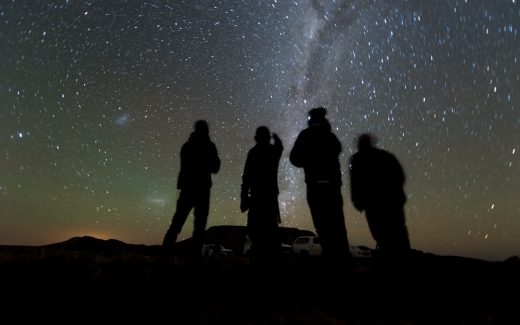
Image: Four members of the South African observation team scan the sky while waiting for the start of the 2014 MU69 occultation, early on the morning of June 3, 2017. The target field is in the Milky Way, seen here from their observation site in the Karoo desert near Vosburg, South Africa. They used portable telescopes to observe the event, as MU69, a small Kuiper Belt object and the next flyby target of NASA’s New Horizons spacecraft, passed in front of a distant star. Credits: NASA/JHUAPL/SwRI/Henry Throop.
As the data from the recent occultation are analyzed, we can look forward to another on July 10 and a third on July 17. For the July 10 event, mission scientists will use the Stratospheric Observatory for Infrared Astronomy (SOFIA), a 2.5-meter airborne telescope mounted in a Boeing 747SP jet. SOFIA can work at 45,000 feet, well above intervening clouds and capable of providing better data than the army of small telescopes used in the June occultation.
For the July 17 occultation, two dozen 40-centimeter telescopes will be deployed to Patagonia, where observers hope to scan more deeply for any debris around MU69. The star being occulted will be the brightest of the three, offering the best prospect for such detections. To track all this, keep an eye on the New Horizons KBO Chasers page, but as we get close to the event check the project’s Facebook page and the Twitter hashtag #mu69occ.
As of this morning, we’re 689,472,210 km from MU69 with 553 days to go until flyby.
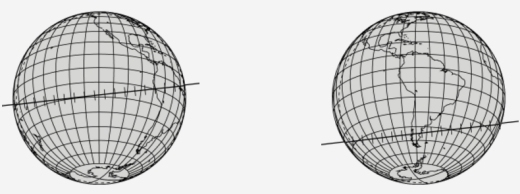
Image: Projected path of the 2014 MU69 occultation shadow, on July 10 (left) and July 17, 2017 (right). Credits: Larry Wasserman/Lowell Observatory.






June 23, 2017
Beam-Riding and Sail Stability
Breakthrough Starshot, the ambitious 30-year plan for launching small interstellar craft to a nearby star, depends critically on the sails that will ride a laser beam to 20 percent of lightspeed. In the essay below, James Benford takes a hard look at where we are now in the matter of sail stability, a subject he and brother Gregory have analyzed in their laboratory work. But as Jim points out, there is a great deal we still don’t know, emphasizing the need for a dedicated test facility in which deep analysis and experimentation can proceed. The Chairman of the Sail Subcommittee for Breakthrough Starshot, Dr. Benford gives us insight into the magnitude of the challenge, and the possible solutions now being considered.
By James Benford

Riding on the beam, i.e., stable flight of a sail propelled by beam momentum, is an essential requirement of beam-driven propulsion. It places considerable demand upon the shape of the sail and beam. Some amount of beam jitter, oscillations in the location of the beam, is to be expected. But even if the beam is steady, a sail can wander off the beam and its shape can become deformed by the high acceleration. Little of the parameter space of possible sail shapes and materials, as well as beam shapes, has been explored to date. Here I describe recent developments.
Sail Geometries
Generally, sails without structural elements cannot be flown if they are convex toward the beam, as the beam pressure would act to compress and perhaps collapse them. On the other hand, beam pressure keeps concave shapes in tension, so conical concave shapes are a possible natural answer to sailship configuration questions, essentially a circular cone. These shapes resist sideways motion if the beam moves off-center, since a net sideways force restores the sail to its original position.
Simulations show that this passive stability works, but it requires suspending the payload below the sail for a more stable configuration. This configuration is a conical shape, perhaps spinning, with the payload hanging from the apex along a tether, which may be flexible, as in Figure 1. It is shaped roughly like a parachute. (Although sails have stress distributions different from a parachute: The beam pressure keeps concave shapes of sail under tensile stress, but the periphery of the sail tends to close, so the sail needs a ring at the largest radius to keep it unfurled. This ring is under compression, and subject to elastic instability.) Such a ring may be a logical place to put the payload, which I think should be distributed to avoid single point failures. I’d much rather have it around the periphery and with some redundancy. One thing I’d don’t like about the “chipsail” idea is that having a single few square centimeter chip on a few square meter sail means that one unfortunate interstellar dust impact will obliterate the payload, losing the mission.
Simulations of conical sails showed the boundaries of sail shape and payload mass giving stability [1]. Simulations at JPL and University of New Mexico showed stability for sail shapes with the conical surface at angles from the horizontal of 25 to 30 degrees, a narrow range. Experiments have verified that beam-riding restoring forces do occur [2]. Stability also depends upon the ratio of the sail mass to payload mass. A recent analysis by Popova et al. showed analytically that stability occurs when the distance from the sail to the center of mass of the entire assembly is larger than the sail radius of curvature for small radius of curvature-L greater than D, the sail diameter [3]. These results mean that the tether must be several times the sail diameter. The mechanical oscillation modes of the tether/payload/sail that affect stability will require carefully analysis.
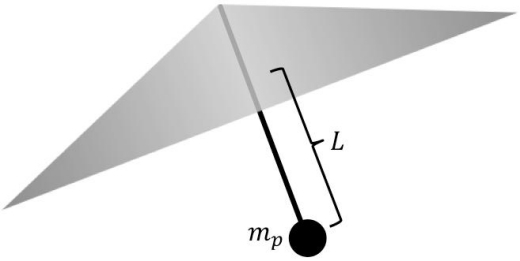
Figure 1 Conical sail with payload of mass mp hanging beneath it, connected by a tether or pendulum bob of length L (Credit: Z. Manchester).
Manchester & Loeb have suggested a spherical sail-hollow, like a shiny balloon, riding on a hollowed-out ‘donut’ beam shape [4]. This architecture has passive stability while also allowing the payload to be inside the sphere, shielded from the laser beam. That’s because it produces a potential well for the sail to sit in, which is stable if the well is deep enough. But the well in the figure is rather shallow. The sail can be inflated into the spherical shape, so could be gas-filled. This hollow beam, composed of 4 Gaussians is just one of many possible “hollow beam” geometries.
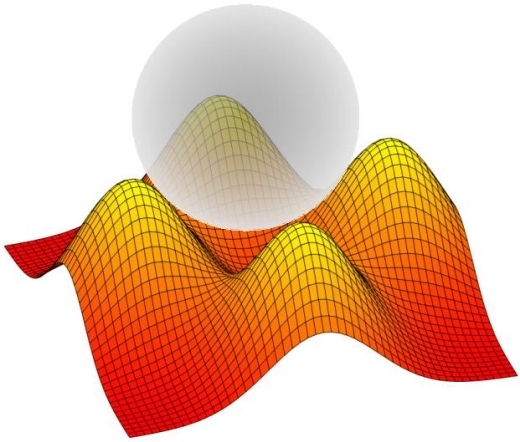
Figure 2 Multimodal beam profile composed of four Gaussian laser beams with spherical sail immersed in them. The corresponding ‘potential well’ for the transverse dynamics of a sail is much shallower than this beam intensity profile. (Credit: Z. Manchester).
From [4] I calculate that, in the example profile of figure 2, 80% of the beam power is lost to the sides of the sail in order to produce this stable regime. That would require that the power of the laser be increased to factor of 5, a huge cost which may be improved using a ring beam with no low areas, through which the sail can escape. Therefore the cost of the spherical sail–hollow beam approach is a big drawback.

Figure 3 A spherical sail will resemble this helium-filled aluminized Mylar balloon. The beam pressure can cause the beam-facing side of the sail to flatten, assuming a more hemisphere shape.
The spherical sail is an idealization akin to that of the “spherical cow” of theoretical physics infamy. In practice, material under about 10,000 g’s acceleration will not remain spherical. It will be deformed under acceleration into an oblate shape, and therefore the spherical symmetry will cease. So will the stability guarantee. The beam pressure causes the beam-facing side of the sail to flatten, so it assumes a more hemisphere shape. Such deformation of the sphere’s surface could cause significant torques on the sail, complicating analysis. This should be explored by modeling and numerical simulations.
Finally, a spherical sail maximizes cross-section to interstellar dust & gas. Compare to a shallow cone, rotated to go edge-on to the direction of travel. The spherical sail must undergo topology change to reveal the payload, and then reconfigure to become an antenna for return of data.
Modeling Sail Flight
Models of sail stability have thus far assumed a perfectly rigid sail. To deal with the many factors involved in sail stability, simulations must relax the rigid body constraint of work up to now. An example of a code geometry that has been studied in simulation is shown in Figure 4.
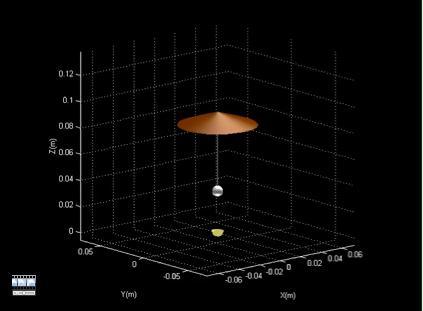
Figure 4 Simulation space for a rigid conical sail with pendulum bob payload [1]. The beamer is directly below the sail.
To address the beam-riding challenge, future simulation codes should include
a large variety of sail shapes and beam profiles,
multiple internal reflections,
sail vibration modes,
sail spin,
simulations must include sail material characteristics including reflection/absorption as a function of angle of incidence.
Codes must also model noise in the system, arising from factors such as perturbations due to atmospheric turbulence, laser pattern variations as well as jitter in the beam and vibrational modes of the sail. While perturbations of the sail will surely excite oscillatory motion, the sail must be in a sufficiently deep ‘potential well’ to remain on the beam.
Conclusion
The parameter space of sail shape and beam shape has been studied to only a narrow, easily accessible extent. The conical sail with a payload hanging below at is the most studied and appears to have some stable regimes. But this is verified only by analytic modeling and limited simulation of the equations of motion. Mechanical aspects of the tether/payload/sail will affect stability and has not been explored. The spherical sail has been studied analytically and appears to be stable only inside a hollow beam, which substantially reduces the efficiency of propulsion.
There is much theoretical and experimental work to be done on beam-riding, an essential requirement of beam-driven propulsion. Beam-riding and sail stability analytical models have reached their limits. Computational models must be substantially improved. Such models can be validated by laboratory experiments. For such a complex problem, only experiments will be decisive.
Looking beyond the distant goal of Star Shot, beam powered sails can play a role in the coming era of interplanetary exploration and eventual commerce. The first useful beam-riding sails will come from such stability studies, which should be undertaken now. In this lower velocity and power regime the dynamics will play out. Such lessons can have great use over decades to come.
[1] D. Georgiev, E. Schamiloglu, C.T. Abdallah and E. Chahine, “3-D Simulations of Rigid Microwave Propelled Sails Using Spin”, Beamed Energy Propulsion, AIP Conf.
Proc. 664, pg. 336, A. Pakhomov, ed., 2003.
[2] G. Benford, O. Goronostavea and J. Benford, “Experimental Tests Of Beam-Riding Sail Dynamics”, Beamed Energy Propulsion, AIP Conf. Proc. 664, pp. 325, A.
Pakhomov, ed., 2003.
[3] H. Popov, M. Efendiev and I. Gabitov, “On the stability of a space vehicle riding on an intense laser beam”, Mathematical Methods in the Applied Sciences, John Wiley & Sons, Inc., 40, pp. 1346, 2016.
[4] Z. Manchester and A Loeb, “Stability of a Light Sail Riding on a Laser Beam”, ApJL 837 L20, 2017.






June 22, 2017
DSTART: Imagining Interstellar Futures
Back in the 1970s, the British Interplanetary Society conceived the idea of designing a starship. The notion grew into Project Daedalus, often discussed in these pages, producing a final report that summed up what was then known about interstellar possibilities, from fusion propulsion to destination stars. Barnard’s Star, 6 light years out, became the target because at the time, it was the only star for which evidence of planets existed, though that evidence later turned out to be the result of error in the instrument being used for the observations (more on this soon, in an essay I’ve written for the Red Dots campaign. I’ll link to it as soon as it runs).
The designing of Daedalus, much of it done in London pubs, was a highly significant event. What Alan Bond, Anthony Martin, Bob Parkinson and the rest were doing was not so much putting forth something that our civilization would build as sending us a clear message. Even at this stage of our development, humans could conceive of ways to reach the stars. There is nothing in the laws of physics that prevents it. What, then, is possible in another fifty years? In a hundred? Even now, the Daedalus concept is being reimagined by Project Icarus.
I think of successive iterations in starship concepts, periodically working through the puzzles in the light of improving technologies. This is why the TU Delft Starship Team (DSTART) has caught my eye. TU Delft is the Delft University of Technology (Technische Universiteit Delft) located in a town known for its canals to the north of Rotterdam. Angelo Vermeulen, now a doctoral candidate in the systems engineering section here, is the founder of DSTART, a collection of students and researchers collaborating on an evolving starship concept.
We just launched a brand new #interstellar initiative at my university: DSTART (TU Delft Starship Team) @tudelft @tudelftTBM pic.twitter.com/Vi7at0ZAhz
— Angelo Vermeulen (@angelovermeulen) March 2, 2017
But Vermeulen deserves further introduction. As well as being a space systems researcher, he is a biologist and artist, and serves as what TU Delft calls a ‘community architect’ in its Participatory Systems Initiative, a determinedly multidisciplinary effort. Back in 2009, Vermeulen created Space Ecologies Art and Design (SEAD), which is an international network developing projects interrelating ecology, technology and community. He has also worked with ESA and NASA, serving as crew commander of the latter’s HI-SEAS Mars simulation in Hawaii. He has held faculty positions ranging from the University of Applied Arts in Vienna to the Philippines Open University in Los Baños. He became a TED Senior Fellow in 2013.
The idea this polymathic researcher is promoting is not to develop actual hardware but to firm up a vision of deep space exploration, one which, says Vermeulen, “…unite[s] the biological, technological and social dimensions. And it is about starships that evolve during their journey.”
This is a multidisciplinary effort drawing on astrophysics, biotechnology, computer simulation, chemistry and art. It should bring to mind Rachel Armstrong’s work on worldships, analyzed in a series of essays in her book Star Ark: A Living, Self-Sustaining Spaceship (Springer, 2017). And in fact Vermeulen was one of the authors of an essay in that volume called “The World in One Small Habitat,” in a section entitled ‘Space Architectures.’
Just how a starship could evolve on journeys taking decades and perhaps longer is fodder for DSTART’s preliminary analysis, which includes near-term in-system technologies like asteroid mining and exploitation, 3D printing and studies in closed loop life support of the kind the European Space Agency is analyzing in a project called MELiSSA. The acronym here unpacks to Micro-Ecological Life Support System Alternative, defined by ESA this way:
… the recovering of food, water and oxygen from organic waste carbon dioxide and minerals, using light as source of energy to promote biological photosynthesis. It is an assembly of processes (mechanical grinding, bioreactors, filtration, wet oxidation, etc.) aiming at a total conversion of the organic wastes and CO2 to oxygen, water and food.
It is based on the principle of an “aquatic” lake ecosystem where waste products are processed using the metabolism of plants and algae which in return provide food, air revitalization and water purification.
“The World in One Small Habitat” looks at MELiSSA in the context of other projects that are exploring closed loop life support. Mastering the huge problems of sustainable ecologies is key to getting humans deep into the Solar System and beyond.
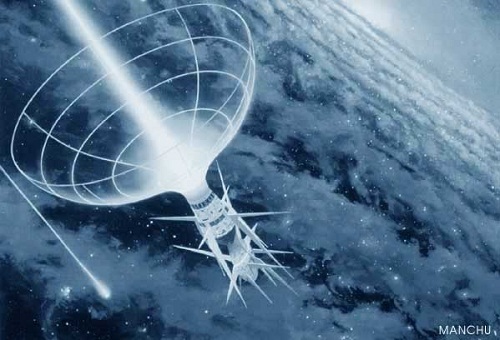
Image: A Bussard ramjet in flight, as imagined for ESA’s Innovative Technologies from Science Fiction project. Credit: ESA/Manchu.
Centauri Dreams has many readers in The Netherlands and nearby. If you’re anywhere in range on Monday June 26, DSTART will be holding a mini-symposium to share its recent work.
PROGRAM
16:00: Evolving asteroid starships, Angelo Vermeulen
16:20: Why interstellar exploration, Jimmy Verkooijen
16:35: Modular starship architecture, Francisco Muñoz Correa
16:55: Modeling a regenerative ecosystem, Alvaro Papic
17:15: Modeling asteroid mining and architectural evolution, Andreas Theys
17:35: The use of VR for interactive starship design, Anton Dobrevski
17:50: Concluding remarks, Angelo Vermeulen
18:00: Drinks
WHEN
Monday June 26, 4-6pm
WHERE
Room H (Wing A), Faculty TPM, TU Delft
Jaffalaan 5, 2628 BX Delft
FOR WHOM
Everyone is welcome. Feel free to bring guests.
Places are limited.
Efforts like these encourage me because they point to increasing interest in the great themes of interstellar exploration. And it’s always heartening to see active university groups tackling these matters — Drexel University’s energetic Icarus Interstellar chapter also comes to mind.
Interstellar crossings are well beyond our capabilities at present, at least at time frames we find acceptable. But we can still come together to analyze the issues and take early steps toward their solution, helping to define problems and clarify research needs. Ad astra incrementis means exactly this: No single breakthrough but steady and progressive steps. Not that we wouldn’t all welcome breakthroughs, but the point is that persistence and hard work are what it takes to move the ball forward even as we remain open to the unexpected.






June 21, 2017
PLATO: Planet Hunting Mission Officially Adopted
The European Space Agency has just announced the official adoption of the PLATO mission. The untangled acronym — PLAnetary Transits and Oscillations of stars — tells us that, like Kepler and CoRoT, this is a planet hunting mission with asteroseismological implications. Photometric monitoring of nearby bright stars for planetary transits and determination of planetary radii should help build our target list for spectroscopic follow-up as we delve into planetary atmospheres looking for biosignatures. Launch is scheduled for 2026.
Asteroseismology studies how stars oscillate, giving us information about the internal structure of the star that would not be available through properties like brightness and surface temperature. PLATO will be carrying out high precision photometric monitoring at visible wavelengths, targeting bright stars (mV ≤ 11), though with capabilities for fainter stars down to magnitude 16. Several hundred thousand stars will ultimately be characterized in the search for planets around G-class stars like the Sun, subgiants and red dwarf stars.
Keep in mind one important difference between PLATO and Kepler. The latter worked with a starfield that was in most cases quite faint, down to magnitude 17. No one can argue with the success of Kepler and its recently released final catalog, but the faintness of many of its stars meant that many planetary candidates have proven difficult to follow up and confirm. PLATO’s wide field will allow monitoring of the brightest stars, which should allow smaller planets to be followed up by ground-based instruments and ultimately confirmed.
“Using observations of stellar vibrations, PLATO will for the first time fully characterize these stars and their planets with regard to mass, radius, and age”, says Prof. Dr. Laurent Gizon, director of the Max Planck Institute for Solar System Research and head of the PLATO Data Center. “This will revolutionize the study of the evolution of exoplanets and their host stars… With today’s adoption, the implementation – the actual building and construction of the spacecraft and its instruments – can begin. In parallel, the design of the software to analyse the observations will be developed at the PLATO Data Center.”

Image: Artist’s impression of one of the new worlds that PLATO will discover. Among those there will be Earth-like planets around Sun-like stars with the potential to host life. Credit & copyright: MPS/ Mark A. Garlick (markgarlick.com).
Bear in mind, too, that unlike the upcoming TESS (Transiting Exoplanet Survey Satellite) mission, PLATO will have the ability not only to do asteroseismology (quite useful in determining the size of exoplanets it discovers), but also to look for Earth-like planets around stars like our G-class Sun. TESS should give us plentiful information about planets around M-dwarfs, but PLATO backs us out to Earth-like worlds around stars like our own.
Using 34 separate small telescopes and cameras, PLATO’s current plan calls for a four-year observation period consisting of long-duration observations of two sky fields lasting two years each. But this could change: ESA also charts an alternative course including a single, three-year long-duration phase and a one year phase with several different pointings. The final strategy is not to be decided until two years before launch, but depending on the choice, the mission will cover between 10 percent and 50 percent of the sky during the nominal mission. An extended mission of up to four years will be a built-in option.
Orbiting the L2 Lagrangian point, PLATO should be able to characterize numerous rocky, icy or giant planets at unprecedented levels of precision, with radius measurements down to 3 percent and mass determinations better than 10 percent precision, assembling a catalog of confirmed and characterized planets with known mean densities, compositions and evolutionary stages, some of them being, it is assumed, planets in the habitable zone.

Image: The PLATO-team at the Max Planck Institute for Solar System Research. Credit & copyright: MPS.
ESA’s point about planetary evolution is telling, especially in light of the work we looked at yesterday on mini-Neptunes and the ‘gap’ between them in Kepler data and smaller, rocky worlds. The focus on highly accurate radius and mass measurements and better determination of stellar ages is designed to give us a better understanding of planetary changes over time.
Terrestrial planets can lose their primordial hydrogen atmospheres, later developing secondary atmospheres and perhaps life. A key goal for PLATO, then, is to study the physical and dynamical processes on Earth-like planets at different epochs in the life of a stellar system, with asteroseismology being a key determinant of host star ages. ESA believes asteroseismology can now determine a star’s age to a precision of 10 percent.
And, of course, we continue the quest for planets in the habitable zone of their star. PLATO’s long-duration observations of a star field should allow the mission to capture two transits of any Earth twin it finds around a G-class star. “With this concept and the high precision of the instrument we will find rocky planets orbiting sunlike stars and will be able to characterise them accurately.” says Heike Rauer (DLR-Berlin), principal Investigator of the mission.






June 20, 2017
A New Classification Scheme for Kepler Planets
As announced yesterday at NASA Ames, the Kepler team has released the final Kepler catalog from the spacecraft’s first four years of data and its deep stare into Cygnus. The numbers still impress me despite our having watched them grow with each new report: We have 4034 planet candidates, of which 2335 have been verified as exoplanets. More than 30 of the approximately 50 near-Earth sized habitable zone candidates have been verified.
The new release brought us 219 new candidates, 10 of them habitable zone possibilities, giving us a final catalog that is our first take on the prevalence and characteristics of planets in the Milky Way, and paving the way for future space-based instruments as we look for targets for atmospheric characterization and direct imaging. By introducing simulated planet transit signals and adding known false signals, the researchers were able to tighten up the catalog, ensuring against errors in the analysis growing out of the team’s processing methods.
The Kepler data are also the subject of a new take on planetary demographics, as seen in the image below, which takes us into the realm of the kind of planets we do not see in our Solar System, so-called ‘mini-Neptunes’ ranging from 2 to 3.5 times the size of Earth.
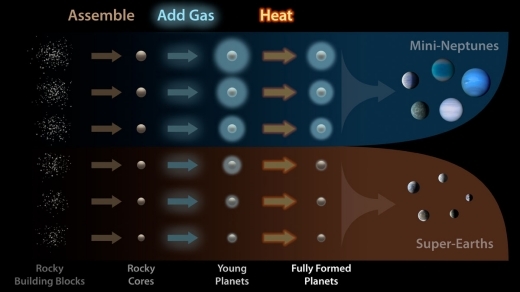
Image: This diagram illustrates how planets are assembled and sorted into two distinct size classes. First, the rocky cores of planets are formed from smaller pieces. Then, the gravity of the planets attracts hydrogen and helium gas. Finally, the planets are “baked” by the starlight and lose some gas. At a certain mass threshold, planets retain the gas and become gaseous mini-Neptunes; below this threshold, the planets lose all their gas, becoming rocky super-Earths. Credit: NASA/Kepler/Caltech (R. Hurt).
A research group working under Andrew Howard (Caltech) has drilled deep into the dataset, measuring the size of 1300 stars in the Kepler field of view to determine the radii of 2025 Kepler planets with four times more precision than had previously been achieved. Out of this work on planetary sizes comes the finding that these planets can be classified into two distinct groups: Rocky Earth-like planets and mini-Neptunes. From the paper:
We find evidence for a bimodal distribution of small planet sizes. Sub-Neptunes and super-Earths appear to be two distinct planet classes. Planets tend to prefer radii of either ∼1.3 R⊕ or ∼2.4 R⊕, with relatively few planets having radii of 1.5–2.0 R⊕. Planets in the gap have the maximum size for a rocky core, as seen in previous studies of bulk planet density and of ultra-short period planets. We posit that the bimodal planet radius distribution stems from differences in the envelope masses of small planets. While our current dataset is insufficient to distinguish between theoretical models that produce the gap, it charts a path forward to unraveling further details of the properties of the galaxy’s most abundant planets.
Although most of the Kepler planets have proven to be between the size of the Earth and Neptune, the planets were previously thought to span the range between the two rather than to fall into distinct groupings. Erik Petigura (Caltech) is a co-author of the new study, which will appear in The Astronomical Journal, along with two other papers that make up an observational program known as the California-Kepler Survey (see citations below):
“In the solar system, there are no planets with sizes between Earth and Neptune. One of the great surprises from Kepler is that nearly every star has at least one planet larger than Earth but smaller than Neptune. We’d really like to know what these mysterious planets are like and why we don’t have them in our own solar system.”
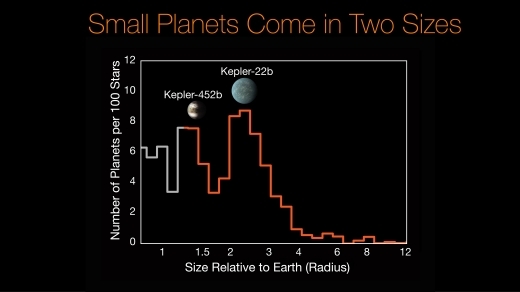
Image: Researchers using data from the W. M. Keck Observatory and NASA’s Kepler mission have discovered a gap in the distribution of planet sizes, indicating that most planets discovered by Kepler so far fall into two distinct size classes: the rocky Earths and super-Earths (similar to Kepler-452b), and the mini-Neptunes (similar to Kepler-22b). This histogram shows the number of planets per 100 stars as a function of planet size relative to Earth. Credit: NASA/Ames/Caltech/University of Hawaii (B. J. Fulton).
The Keck work involved researchers at UC Berkeley, Harvard, the University of Hawaii, Princeton and the University of Montreal as well as Caltech, a multi-year project analyzing the Kepler spectral data to obtain precise measurements of the host stars, which then allowed the scientists to refine the sizes of the planets orbiting those stars. Why the planets exist in two distinct groups — with a clear gap between rocky Earths and mini-Neptunes — remains problematic. Are Earth-sized planets the norm, with some of them simply obtaining enough of a gas envelope to become mini-Neptunes? Andrew Howard comments:
“A little bit of hydrogen and helium gas goes a very long way. So, if a planet acquires only 1 percent of hydrogen and helium in mass, that’s enough to jump the gap. These planets are like rocks with big balloons of gas around them. The hydrogen and helium that’s in the balloon doesn’t really contribute to the mass of the system as a whole, but it contributes to the volume in a tremendous way, making the planets a lot bigger in size.”
On the other hand, the researchers speculate, it may be that planets without enough of a gas envelope to fall into the gap can lose gas because of radiation from the host star. In this scenario, planets that wind up in the gap aren’t likely to stay there for long, producing thin atmospheres that are quickly blown off. Either scenario produces the populations we see in the new data, but we’ll need to learn more about the composition of mini-Neptunes to get a picture of why they seem to form so easily around other stars but not around our Sun.
The paper adds this:
…making a planet with a thin atmosphere requires a finely tuned amount of H/He. Second, photoevaporating a planet’s envelope significantly changes its size. Our observation of two peaks in the planet size distribution is consistent with super-Earths being rocky planets with atmospheres that contribute negligibly to their size, while sub-Neptunes are planets that retain envelopes with mass fractions of a few percent.
Three papers from the California-Kepler Survey are now available on the arXiv site in preprint form, all of them accepted for publication at The Astronomical Journal: Petigura et al., “The California-Kepler Survey. I. High Resolution Spectroscopy of 1305 Stars Hosting Kepler Transiting Planets” (preprint); Johnson et al., “The California-Kepler Survey. II. Precise Physical Properties of 2025 Kepler Planets and Their Host Stars” (preprint); and Fulton et al., “The California-Kepler Survey. III. A Gap in the Radius Distribution of Small Planets” (preprint).






June 19, 2017
Pale Red Dot: Campaign 2
The Pale Red Dot campaign that discovered Proxima Centauri b produced one of the great results of exoplanet detection. For many of us, the idea that a world of roughly Earth mass might be orbiting in Proxima Centauri’s habitable zone — where liquid water can exist on the surface — was almost too good to be true, and it highlighted the real prospect that if we find such a planet around the closest star to our own, there must be many more around similar stars. Hence the importance of learning more about our closest neighbors.
Which is why it’s so heartening to see that Pale Red Dot is by no means done. This morning, the team led by Guillem Anglada-Escudé (Queen Mary University, London) announced plans to acquire data from the European Southern Observatory’s HARPS instrument (High Accuracy Radial velocity Planet Searcher) in a new campaign to study not just Proxima Centauri in search of further planets, but also the red dwarfs Barnard’s Star and Ross 154.

Also involved will be a network of small telescopes performing photometric monitoring, including the Las Cumbres Global Observatory Telescope network, SpaceObs ASH2 in Chile, the Observatorio de Sierra Nevada and the Observatorio Astronómico del Montsec, both in Spain. But the star of the show continues to be HARPS, a high-precision spectrograph attached to the ESO’s 3.6-meter telescope at La Silla. HARPS is capable of detecting radial velocity motions down to 3.5 kilometers per hour, the pace of a leisurely evening walk.
Image: Lead author Guillem Anglada-Escudé speaking at a press conference in Garching, Germany about the 2016 discovery of Proxima Centauri b. Credit: ESO/M. Zamani.
Are there other planets around Proxima Centauri? The findings around TRAPPIST-1, all seven of them, give reason to hope that we’ll make further discoveries. As to Barnard’s Star, we still have no information about planets there, although for a time in the mid-20th Century, it was thought due to instrument error that there might be one or more gas giants orbiting the star. We know now that that isn’t the case, but the possibility of terrestrial-class worlds remains.
I’ll have more to say about that situation later in the week, but do want to note that the reason the Project Daedalus planners chose Barnard’s Star as their mission target was the supposition that those planets existed. Proxima Centauri would obviously have been a closer target.
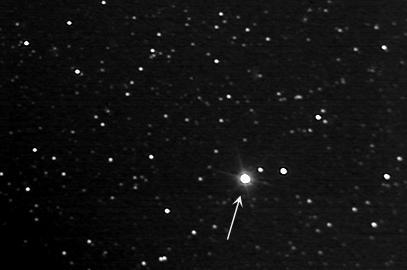
Image: Barnard’s Star ca. 2006. Credit: Steve Quirk.
The M-dwarf Ross 154 is just under 10 light years from Earth, the nearest star in Sagittarius. That distance is closing at a good clip (in astronomical terms), so that the star will come to within about 6.4 light years in another 157,000 years. Like Proxima Centauri, Ross 154 is a UV Ceti-type flare star, producing major flares on the order of every two days. Given that flare activity in M-dwarfs is a major factor in the question of whether life can develop, finding planets close enough to be characterized by later space and ground telescopes would be a significant development, and the more systems the better to allow comparative analysis.
It will be fascinating to watch the new Pale Red Dot campaign develop, for these observations will be highly visible to the general public. While Pale Red Dot presented its results on Proxima b to the public only after extensive peer review, the observational data from the new campaign, beginning with Proxima Centauri, will be revealed and discussed in real time.
#ESOCastLight on #RedDots — the hunt for the nearest exoplanets #BiteSizedAstronomy #4K #UHD https://t.co/X1aFyJSHFO pic.twitter.com/9PU1f8TqSD
— ESO (@ESO) June 19, 2017
The scientists involved intend to maintain an active social media presence supported by various online tools. Keep an eye on the Red Dots Facebook page, the Red Dots Twitter account and the #reddots hashtag, as well as the main project page, where updates and featured contributions from the community will be posted on a regular basis.






Paul Gilster's Blog
- Paul Gilster's profile
- 7 followers



